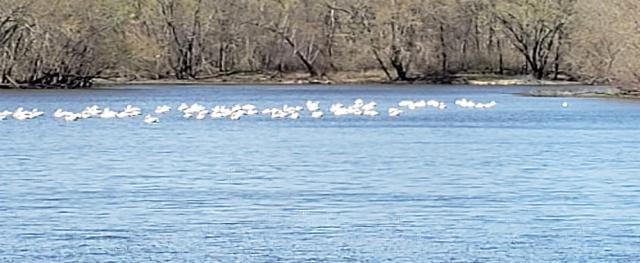"Pelicans were on the lake by Izaak Walton this morning," reported Joan Lindberg on Wednesday.
If you're like me, you double-checked to see if Pelicans are indeed in Iowa. According to the DNR, the population of Pelicans has started to grow. In the mid-1900, chemicals like DDT had decreased the populations by making its way into the fish that pelicans ate and ultimately poisoning the birds.
Pelicans are not into social distancing. The birds are a very social group nesting together in colonies. Some of the largest colonies have reached 5,000 birds. The birds fish together by forming a semi-circle around a school of fish and then dipping their beaks in the water so that the fish will go toward shallow water where the birds scoop them up. Pelicans here can be seen going "bottoms-up" as opposed to the coastal pelicans who dive underwater for their fish.
The Pelicans don't carry water or fish in their beak while flying. (Sorry Nemo) Their pouches can, however, hold up to five gallons of water, which helps the pelicans to catch a lot of fish in one bite. Once they get a mouth full, the bird tips their heads back to let the water spill out the sides of their beak, and their pouch contracts. They swallow the fish headfirst. About a third of the time the pelicans are successful in stealing food from other birds.
If you get close enough to see their beaks, you might observe a "Baby Bump." The birds have a lump that forms on top of their beak and it falls off after the birds have mated and laid eggs. No one knows what the purpose of the bump is, During breeding season their coloring includes vivid orange feet and nills, and the feathers are pearly white, except for a line of gray feathers under their wings. When it's not breeding season the birds will grow a patch of dark feathers on the nape of their neck and their feet and bills turn a yellowish color...and they lose their "baby bump."
The birds usually only have one baby chick survive out of sometimes six that they lay. Both the males and females incubate the chicks which require 150 pounds of food to get them to adulthood.
Coyotes prey on the birds while their eggs and baby chicks are eaten by eagles, owls, foxes and sometimes other pelicans. The parents will often protect their chicks from small predators, but flee if they see a large animal approaching.
The birds will grow to about four feet tall and can weigh anywhere from 10-30 pounds, having a 10-foot wingspan.
So yes, we do have Pelicans in Iowa and they can be seen along the river or near the water just north of Vinton.

Comments
Submit a CommentPlease refresh the page to leave Comment.
Still seeing this message? Press Ctrl + F5 to do a "Hard Refresh".
Karolynn